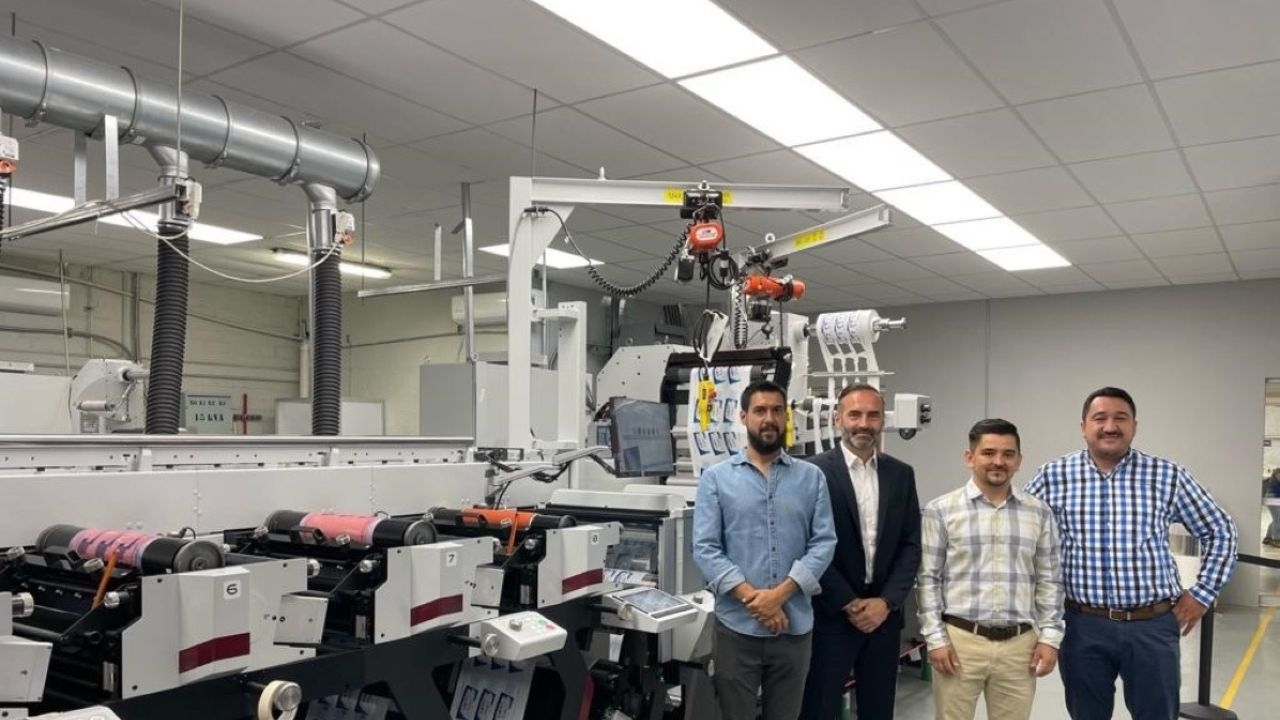Mark Andy confident of continued Latin American success
Two years on from a record-breaking 12 months of sales in Latin America, Mark Andy continues to be bullish about the region’s growth prospects – and Mexico in particular. James Quirk reports

Mark Andy confident of continued Latin American success
Press manufacturer Mark Andy achieved record sales in Latin American in 2021, with nearly 30 machines sold. Two years later, John Vigna, the company’s sales manager for the region, continues to be bullish about growth prospects in the market.
What was behind that record year? Vigna points to a number of factors. Pent-up demand after a slow, locked-down 2020 played a part, he admits. But also important were internal business strategies and local market developments that continue to bear fruit today, and explain the continued optimism.
Strategy
‘2020 was a difficult year, particularly in the US,’ he recalls. ‘I had taken over from John Cavey [as Mark Andy’s Latam sales manager] but the lockdowns made it feel like having a Ferrari in the garage that you couldn’t drive. Then toward the end of 2020 we started to pick up some momentum in sales, and 2021 started really well.’
In the meantime, Vigna had been putting some important building blocks into place, including the appointment of Kenjiro Celaya as Mexico sales manager, and contracting a US-based but, crucially, Spanish-speaking financier to provide financing options to customers.
Celaya had previously worked as the plant manager of a leading Mexican label converter and a long-time Mark Andy user. ‘Kenjiro’s arrival helped us to penetrate the Mexico market more,’ says Vigna. ‘We wanted someone who knew our machines, and who had experience with our competitors’ machines as well.’
The appointment of Celaya echoed the strategy Mark Andy had been successfully adopting in Europe in recent years: adding local expertise. ‘We can offer different options,’ says Celaya. ‘We are a good team.’
Meanwhile, the new financier knew the Latin American region, could communicate directly in Spanish, and provided ‘much better’ financing options that suited the local market, according to Vigna.
As economies reopened after pandemic-induced lockdowns, sales soared – nearly 30 machines in the next 12 months, spread across eight countries – resulting in the company’s record-breaking year.
The machines varied widely in model and technical specifications, from the entry-level 10in 2200 Series to a 20in Performance Series P7 and 14 new Evolution Series (13 E5 and one E3) on the flexo front, to a Digital Series HD and Digital Pro 3 in the hybrid market.
Among the many sales were a number of landmark installations. Flexoprint in Brazil installed its first two Mark Andy presses, through local representative Miguel Troccoli of PTC. Fellow Brazilian converters Gráfica Cometa and Softcolor acquired their first Mark Andy presses: an Evolution Series E3 and 17in Performance Series P7 respectively – the latter the first machine of its kind installed in the country. Autopel bought a Performance Series P5 and then added an Evolution Series E5, the first in Brazil. In Belo Horizonte, Maxcor brought its total of Mark Andy presses to 16 with the addition of three 2200s and an E5. At the same time, international group Sato acquired a Performance Series P7 for its plant in Brazil and an E5 for its plant in Argentina.
Vigna points to the high specification of many of the presses installed during this period as encouraging evidence of local market development, with many customers across the region moving into the production of shrink sleeves, in-mold labels and flexible packaging. RFID is another area of growing interest. Beontag – now the second-largest RFID supplier globally – installed a 20in Mark Andy Performance Series P7 equipped with a Tamarack RFID unit at its plant in Paraná, Brazil.
But perhaps the most noticeable trend, says Vigna, is increasing interest in digital printing from converters in the region – and, in particular, Mark Andy’s hybrid offering, which includes four presses aimed at different market segments. Testament to this was the landmark installation of a 17in Digital Series HD – the first in Latin America – at Guadalajara, Mexico-based Etipress. The hybrid press combines the Performance Series servo platform with a 1,200 DPI 8-color inkjet engine and various add-ons thanks to a modular configuration.
‘We are facilitating this growth in the industry through our hybrid range,’ says Vigna. ‘It brings such flexibility: you can combine any printing process with digital, so it allows our clients to be able to offer something different to their customers.’
Mark Andy’s record-breaking 2021 continued into a successful 2022. ‘Not quite at the same levels as 2021,’ says Vigna, ‘but we expected that.’ However, the one press technology that has seen even more success than during that record-breaking year is hybrid.
Among the increased number of installations, a Digital Pro 3 and a Digital One were sold to customers in Chile through newly appointed distributor Solugraphics.
In Mexico, hybrid machines installed last year included a further Digital Series HD, among other models.
Mexican Market
‘There are lots of dynamic markets in Latin America,’ emphasizes Vigna. Mark Andy has seen particular success in recent years in the region’s biggest markets: Mexico and Brazil. Chile is also ‘performing strongly’, while Central America – especially Guatemala and El Salvador – has also proved a fertile hunting ground, says Vigna.
But Mexico – the location in April this year for the first Labelexpo show in Latin America – is providing particular cause for optimism. ‘Labelexpo taking place in Mexico shows the strength of the local economy,’ says Celaya. ‘We are excited to be able to host the show.’
Mark Andy installations in the country have continued apace in the past 18 months, with Etipress, Sama Etiquetas, Grupo Etytec and Standard Register Latam just four of the companies who have recently added presses.
A key legacy of the pandemic has been a shift in attitude toward supply chains. Disruption during the pandemic, increasing geopolitical tensions, and rising labor costs in China have led to many companies seeking to streamline their supply chains and manufacture closer to their consumer markets: a trend known as ‘nearshoring’.
Mexico – with its long border with the United States, tax advantages offered by trade agreements, and highly trained workforce – has been a strong beneficiary, though the effects are being felt elsewhere in Latin America too.
The country has seen an influx of foreign companies setting up local manufacturing operations. Foreign direct investment increased by 12 percent in 2022 compared to the previous year, reaching $35.3 billion USD, according to the Mexican Ministry of Economy, which has identified a further 400 international companies that are interested in making the move.
The Mexican automotive industry is a case in point. It had its largest increase in production in the last eight years in 2022: car production increased by 9.2 percent, according to the National Institute of Statistics and Geography, while exports rose by 5.9 percent. The sector has been further boosted by Tesla’s plans to invest some $4.5 billion USD in a new plant in Nuevo León with the capacity to produce more than a million electric cars a year.
‘In the US, there has been a shift in mentality,’ says Vigna. ‘Buying goods from China has become less popular. Mexico has been benefitting. We are seeing more converters in Mexico focused on serving the US market and exports of labels are rising.’
‘We’ve seen many foreign technology companies from Europe and Asia setting up facilities in Monterrey and other areas in the north of the country, in order to serve the US market,’ echoes Celaya.
‘There are challenges, of course. But when you compare it to how it was, it’s night and day. We have a much more mature market with a more mature supply chain. The level of technology is growing rapidly and there’s a real hunger for more. There’s a lot of potential here.’
Mexico is also seeing strong growth in e-commerce. Despite predictions that it would fall after the pandemic when lockdowns stimulated a surge in online buying, eCommerce continued its inexorable rise with growth of 23 percent in 2022 compared to the previous year, according to the Mexican Association of Online Sales. Online sales are now treble what they were in 2019.
Meanwhile, Mordor Intelligence forecasts that the Mexican market for printed labels is expected to register a CAGR of 5.5 percent between 2021 and 2026, while Mexican association Canagraf estimates that the number of label converters in the country has risen from some 300 companies a decade ago to around 450-550 today. ‘Because of nearshoring – and other factors – we are confident that we will maintain good growth in the region in the next few years,’ says Celaya. ‘It is a good moment for the Latin American market.’
‘I’ve been working in Latin America for more than 20 years,’ says John Vigna. ‘It is great to see how far the region has come.’
Stay up to date
Subscribe to the free Label News newsletter and receive the latest content every week. We'll never share your email address.


